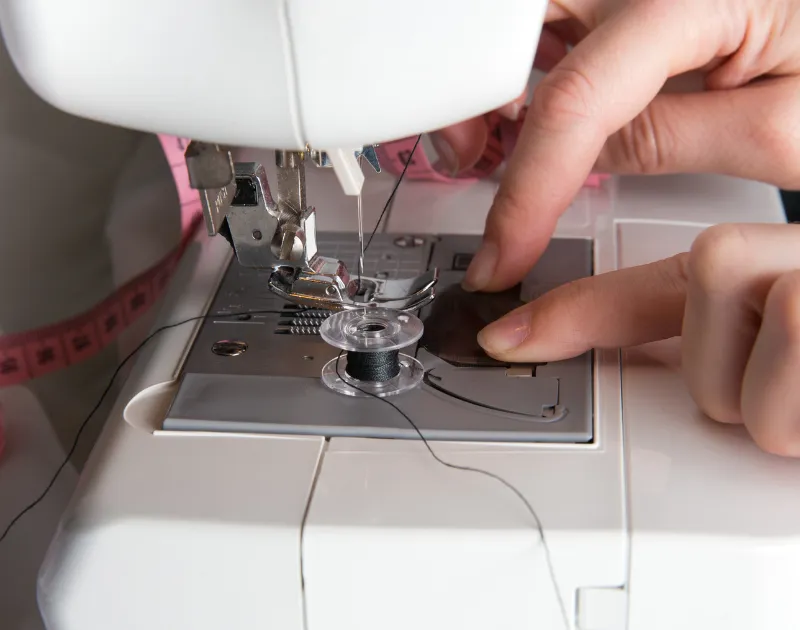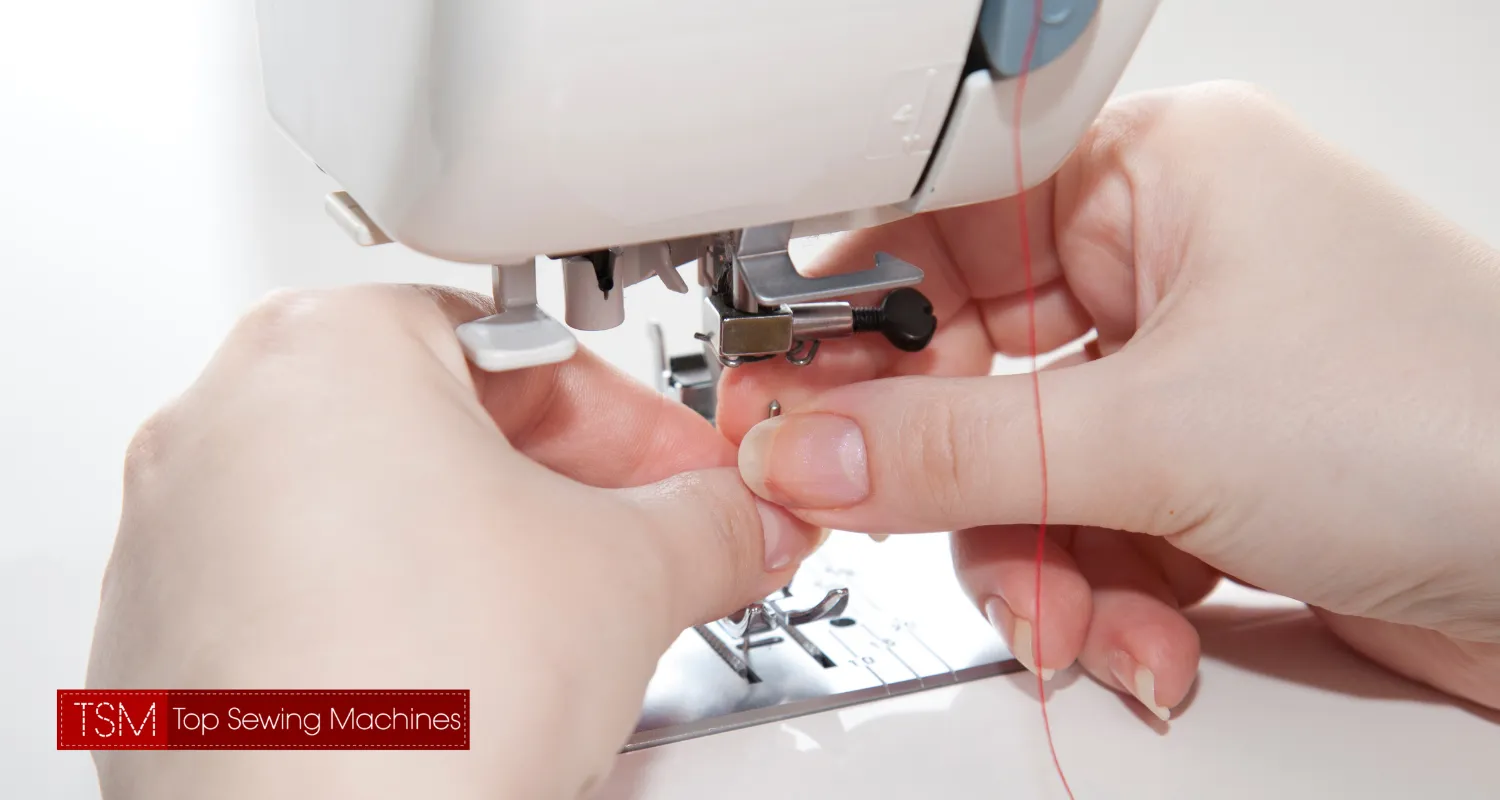Whether your sewing machine is skipping stitches on the bottom of your material or the stitches are too loose at the bottom, this can result in improper sewing on actual fabric and be frustrating for sewing machines beginners.
If your sewing machine is not stitching on the bottom then it could be down to common sewing machine problems such as a bad needle, the wrong thread, incorrect thread tension or just a malfunctioning modern sewing machine.
Luckily, most of these basic sewing machine issues are easy to remedy, and you will be on your way to have perfect stitches on the bottom of your fabric, to help you out, we have put together our guide below that troubleshoot your modern sewing machine and get it working again how it should be.

As we mentioned above, modern home sewing machines will often skip or have loose stitches on the bottom of your fabric if you have not threaded the sewing machines needles properly or the tension dial is not set right.
This can ruin the quality and most importantly the strength of your sewing machine stitches on the fabric.
We have listed the common issues which cause these missed stitches down below so you can troubleshoot your machine.
One of the first problems to check on your modern sewing machine is the needle. You need to make sure you are using the right type of needle and correct size needle according to the combination of fabric you are sewing, trying to use a small needle on fabric could result in missed stitches.
For example, when sewing woven fabrics you have to make sure you are using an all-purpose needle.
Another point to check about the sewing machine needles is the quality of the needle itself, if the needle is bent or blunt, you might need a fresh needle as this can mess with your stitch pattern too.
Bad threading can cause poor stitches on the bottom of the fabric, to thread your machine correctly you should ensure you are using the correct amount of thread, not too long or short and that the thread itself has no knots and is of good quality.
To thread a modern sewing machine right you need to ensure that the presser foot of your machine is raised when threading so as it can slot between the tension discs, you can then feed it through the guides of your machine and take up the lever in the correct position.
If the bobbin thread is not threaded right it can result in loose bottom stitches. The bobbin tension mechanism should be correct with the thread not too tight or too loose and it should pass through the bobbin case. Always use a new bobbin thread before sewing and take time to do the bobbin winder properly without rushing.
You should also ensure that you are using the right bobbin for your types of sewing machines.
When setting up your sewing machine thread tension you must make sure the tension is not too tight or too loose. A too loose tension on the top thread will cause a loose bottom thread which can cause stitches to miss.
Finding the right top and bottom basic tension for your modern home sewing machines can typically be found in the manual.
Any damaged parts of modern home sewing machines can cause a sewing machine to malfunction and not stitch properly on the bottom of your material. On household machines or domestic machines, parts such as the bobbin or spool pin could be affecting thread tension causing stitching issues.
Finding a solution to missing or loose stitches on the bottom of your material can be a little difficult as a beginner sewer, but once you troubleshoot your machine with our suggestions above and follow the correct directions from your machine manual, you will know what the issue is.
We have listed a few fool-proof ways below to fix your sewing machine stitches below.
If your bottom thread is looping on your bit of fabric then correcting the upper tension of your thread will help. To do this, tighten the upper tension to prevent the uneven stitches, this can be done via the tension discs.
Re-insert the bobbin and make sure it is in the correct position with the right kind of thread and most importantly smooth thread without any knots.
Balancing the tension of your sewing machine will stop it from looping or missing threads, this can be done in a few ways such as by; using a thick thread to balance tension, or tightening the tension as we explained in a troubleshooting guide.
Try holding the thread with one hand then moving the wheel counterclockwise, after this leave the needle then pull the thread from the lower side. It is worth noting that different needles and fabrics will always need different tensions so you need to check thread tension requirements beforehand.
Servicing your household machines or domestic machines should be done at intervals to ensure proper performance, changing sewing machine oil as well as cleaning parts is important for proper stitching, as dust can cause blockages resulting in skipped stitching.
We will cover how to maintain your household machines in depth later on in our guide.
If your try the above steps and nothing is working, lastly try to re-thread your whole sewing machine instead to ensure proper set-up and tension.
Hold the thread with one of your hands then on the opposite side unwind it, then place the bobbin thread in the bobbin case. Make sure there is even tension throughout the disc in the bobbin winder shaft.

Sewing machine maintenance is quick and easy to do according to your sewing machine manual and stops any problems such as missed stitches or household machines parts ruining the performance of your machine.
We have listed out the main steps to correctly maintaining your sewing machine down below.
Brushing the moving parts of your household machines design down is important for it to function properly. A build-up of debris such as dust can block the mechanical machine from sewing properly. Ensure the brush you use is new and doesn't break off inside of the parts.
After using your machine take some time to wipe it down with a rag, this will remove any dust build-up around areas such as the bobbin winder keeping your machine functioning smoothly.
Having compressed air on hand to clean your sewing machine is super important as it helps you remove debris from the areas which you cannot reach with a rag.
Take time to remove lint or any areas where the thread is in your machine, this could be blowing around the feed dog, bobbin hook, and tension discs, make sure you blow in a direction where the lint will be removed, not forced further into the machine.
When not in use, you should use the protective cover that comes with your mechanical machine to stop dust from building up or buy a cover for it if yours did not come with one.
As we mentioned above in our troubleshooting guide, bad needs that are blunt or bent can be a reason for poor stitch quality, so it is important to change out the needle on your model after every 8 hours of sewing.
Never try to use the wrong needle on material, as not only will this result in poor stitch quality but it will wear out your needle faster too.
Sewing machines that are lubricated well will perform much better, you may only need a drop of oil, but doing this regularly goes a long way. Always check the instruction manual of your machine to see which kind of oil they prefer for lubrication.
How often do I need to oil my sewing machine?
Figuring out when to oil your machine is not easy, as it is variable according to how much you use it. This could be twice a year if you sew every day, or when your stitching sound becomes louder.
What's the best way to thread a sewing machine properly?
To thread a sewing machine correctly you must first use the bobbin winding lever to wind the bobbin, press the correct foot until the bobbin is completely winded. Raise the presser foot as you thread the machine, take the bobbin and put it in the correct bobbin position within the case.
Turn the handwheel towards you, raise the needle then guide the thread end through the thread guide of the machine, thread the thread end through the eye of the needle, hold the end, raise the hand lever and pull the bobbin thread tail.
Bring both thread tails to the back of the needle and being sewing.
How to know if you are using a quality thread?
A quality thread will not have any loose fibres and be tightly spun, thread that breaks often even with sharp needles or knots up quickly too is also an indicator the thread is of a poor quality which in turn will cause a poor stitch quality.

Overall, if your sewing machine is not stitching on the bottom of your fabric correctly then you likely need to troubleshoot the bobbin, tension or threading of your machine. Also, make sure to maintain your sewing machine when needed with regular cleaning and needle changes/oil top-up to ensure it is working at its maximum performance.



